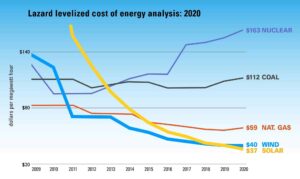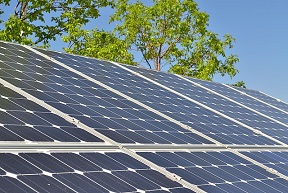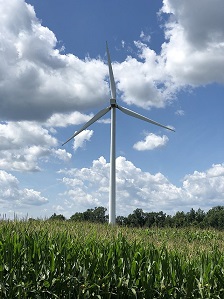This month, before publication of their NZE2050 scenario, the International Energy Agency considerably upped its forecast for solar and wind energy. Even after the major upward revision already done in its World Energy Outlook 2020. Solar PV is now ‘the cheapest source of electricity in history’. And more pleasant surprises may be underway. A recent study shows that the low carbon transition may be much cheaper than models predict.

Unpreced-ented growth
For fifteen years at a stretch, IEA predicted that solar and wind energy growth would slow down. And then, it didn’t – year after year. In 2020, renewables even added a whopping 45% to the 2019 capacity. Percentage growth hadn’t been at this level since 1999 (but in terms of capacity added, the 2020 volume was almost ten times that of 2000!). In its November 2020 projection, IEA still thought growth would flatten out. Now, in May 2021, it adds 25% to its 2021 forecast. It even projects that this ‘exceptional’ level of growth will become the ‘new normal’ in 2021 and 2022. It judges that further acceleration may be possible in the years after. Even that may be an underestimation, as actual developments of solar and wind energy have already overtaken the upped projection.
But this growth might not be ‘exceptional’ at all. It is no more, no less than the continuation of the trend of at least fifteen years. These insights led us five years ago to the publication of our 50-50-40 scenario: towards 50% renewable energy and 50% traditional energy in 2040. Propelled by two factors. Firstly, energy consumption growth will level off; because there is an increasing number of efficient energy use technologies. And secondly, renewable energy production will rise. Foreseeable because there is a large number of innovations (and hence price reductions) in the technological pipeline. Of course, IEA could oversee all this as well, and even better than we could. But they adhered to the ‘acceptable’ view that these ‘gadgets’ would somehow peak in the near future. Or they were blinded by their expertise. Or both. Till they made their latest turnaround.

Records
‘Solar PV development will continue to break records,’ IEA writes now, ‘with annual additions reaching 162 GW by 2022 – almost 50% higher than the pre-pandemic level of 2019. Global wind capacity additions increased more than 90% in 2020 to reach 114 GW. While the pace of annual market growth slows in 2021 and 2022, it is still 50% higher than the 2017-2019 average.’ And the world’s best solar power schemes now offer the ‘cheapest…electricity in history’.
Investment in renewable energy now outperforms investment in traditional energy production. Over 90% of electricity generation capacity added in 2020 was in renewables – and 2021 and 2022 will see the same. The biggest growth of solar and wind energy was in China and India; growth there is expected to continue. And then, the new figures haven’t yet taken into account the effects of the Biden administration’s new measures in the US. These IEA messages differ essentially from earlier messages that tended to (severely) underestimate solar and wind energy.

Solar and wind energy cheapest source in history
Part of the story is that IEA always overestimated capital costs of solar and wind energy; the most important cost factor. Now, IEA shows solar electricity prices to be 20-50% cheaper than they previously thought. Some difference! IEA used to assume annual cost of capital to be 7-8% of the investment. But they now discovered – better late than never – that these costs are more likely to be in the range of 3-5%. Largely as a result of policies designed to reduce the risk of renewable investments. Says IEA: ‘For projects with low-cost financing that tap high-quality resources, solar PV is now the cheapest source of electricity in history.’ Within a few years, renewables will generate more electricity than coal.
A recent paper in Environmental Research Letters by prof Michael Grubb et al adds even more force to this development. The authors show that financial models of solar and wind energy severely overestimate lifetime costs of projects. That is because renewable energy costs come down much faster than predicted. The models assume a fixed cost reduction over time; but because renewable technologies grow much faster than predicted, prices come down faster. There is a virtuous circle at play here. Because more renewable equipment is being installed than previously thought, prices come down faster than previously thought; and then again, more equipment is being installed than previously thought. If energy policy would acknowledge this mechanism, we would invest even more in renewable equipment.
Cost reduction
On carbonbrief.org, the authors write: ‘models that do not account for the dynamics that lead to such developments are likely to vastly underutilise key technologies and overestimate costs.’ In terms of innovation policy: most models concentrate on technology push, but severely underestimate the effects of demand pull. Models particularly underestimate the effect of stimulation policies, like the use of feed-in tariffs. Much of the cost reduction in solar and wind energy comes from learning-by-doing and economies of scale; as supply chains and markets develop, stimulated by such tariffs. The authors therefore find that early investment will result in lower energy system costs. Most models however favour slow investment, waiting for prices to come down; over time, this strategy will result in higher costs.
These favourable developments for solar and wind energy have led to IEA’s recent net zero carbon emissions scenario NZE2050. A major step forward. In a press release announcing the new solar energy figures, IEA chief executive Fatih Birol says: ‘Wind and solar power are giving us more reasons to be optimistic about our climate goals as they break record after record. Last year, the increase in renewable capacity accounted for 90% of the entire global power sector’s expansion. A massive expansion of clean electricity is essential to giving the world a chance of achieving its net-zero goals.’
Interesting? Then also read:
Perspective on renewable energy rapidly changing
BP redresses its low renewable energy forecasts – too little, too late
Renewables versus nuclear – a choice already made
